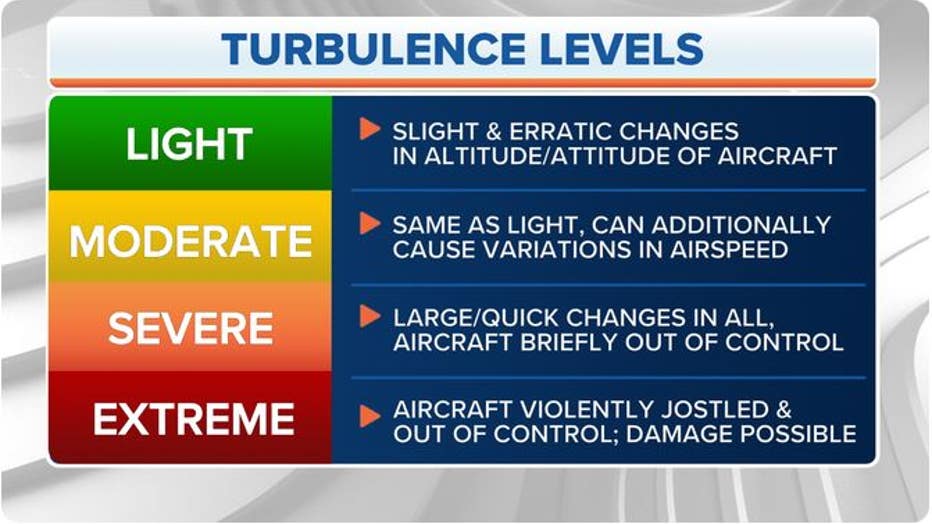Here's what causes turbulence and why you shouldn't be afraid

TPA offers free guided tours
Tampa International Airport is resuming its guided tour program after a long hiatus due to the pandemic.
Most passengers hate it, and it's one of the most unpredictable nuisances to pilots. So what exactly is turbulence?
Turbulence is a sudden and sometimes violent shift in airflow. Those irregular motions in the atmosphere create air currents that can cause passengers on an airplane to experience annoying bumps during a flight, or it can be severe enough to throw an airplane out of control.
"(The pilots) aren't scared at all. It's all a part of aviation," United Airlines pilot Rob Biddle said. "It's a common occurrence. There's very rarely a flight where we don't experience some level of turbulence."
Think of it as bumps in the road when you're driving or what it feels like when you're on a boat that sails over waves.

American Airlines plane that landed in Alabama after turbulence injured eight people.
SEVERE TURBULENCE IN THE SKIES OVER THE SOUTHEAST INJURES 8 ABOARD AN AMERICAN AIRLINES FLIGHT
What causes turbulence?
The National Weather Service explains several different causes of turbulence:
1: Mechanical Turbulence - This type of turbulence occurs when a solid object, like a building or mountain obstructs the flow of air.
2: Thermal (Convective) Turbulence - This type of turbulence occurs when the sun heats the surface of the earth and causes the air above it to warm up and rise. It mixes with cooler air that's falling, and that is responsible for some of the bumps you may experience on a flight.
3: Frontal Turbulence - This type of turbulence occurs by the lifting of warm air by sloping frontal surface and friction between two opposing air masses. This is most common when thunderstorms develop.
4: Wind Shear - This type of turbulence will occur when there is a change in wind direction and/or speed over a specific horizontal or vertical distance. When the change in wind speed and direction is pronounced, severe turbulence can be expected.
5: Clear Air Turbulence - This type of turbulence occurs at or above 15,000 feet and is felt when the plane moves in between air masses moving at different speeds or directions.
"Clear turbulence has always been a problem," United Airlines Evaluator Capt. Jeff Arnold said. "Obviously thunderstorms, we can see it. We know it's going to be turbulent. We avoid it. We can see it on our radar. Clear turbulence has been a problem."
That's why pilots always tell passengers to have their seatbelts fastened, even if it's a relatively smooth flight. Because in a matter of seconds, all that can change.
LIGHTNING STRIKES ON AIRPLANES CAN BE SCARY - JUST ASK MILEY CYRUS
How intense can turbulence get?
The intensity of turbulence that is reported by pilots is usually classified as light, moderate, severe or extreme.

Turbulence can range from light to extreme. (FOX Weather)
If you're a passenger on a flight that experiences turbulence, you may have different sensations when the plane is bumping around 35,000 feet in the air.
LIGHT: Passengers may feel slight strain against seat belts.
MODERATE: Passengers feel definite strains against seat belts. Unsecured objects are dislodged. Food service/walking are difficult.
SEVERE: Passengers are forced violently against seat belts. Unsecured objects are tossed around. Food service/walking are impossible.
FAA, AIRLINES WORK TO IMPROVE GRIDLOCK IN SKIES OVER FLORIDA
Should you be scared of turbulence?
The short answer is no, and rest assured that the pilots know how uncomfortable turbulence can make passengers feel.
"I think it's the uncertainty," Capt. Marc Champion, Managing Director of Flight Training at United Airlines, said. "I think it's being in the back of an airplane where you can't really see what's ahead of you. You don't know what's behind you. All you see is what's outside the window."
While it may feel unnerving sitting on a bumpy flight traveling hundreds of miles per hour at thousands of feet in the air, there's no reason to panic or worry.
Turbulence is unavoidable. It’s experienced on almost every flight to some degree (usually light).
Just remember that modern aircraft are put through extreme testing that puts the aircraft to its limits in conditions far worse than any turbulence could produce. Pilots are put through the same amount of training and testing to make sure they know what to do when turbulence suddenly rocks the aircraft up and down or side to side.
"Every nine months, we go for recurrent training and check rides," Biddle said. "Throughout the training and check rides, we always get those opportunities to practice."
Get updates on this story from FOX Weather

